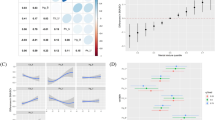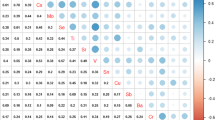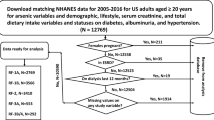Abstract
Purpose
Urinary metals can be used to identify metal exposure in humans from various sources in the environment. Decreased renal function and cardiovascular dysfunction may occur due to low levels of metal exposure in the general population. The purpose of this study is to assess the association between urinary arsenic and metals and a higher albumin to creatinine ratio (ACR) among adults in the general US population.
Methods
We conducted a cross sectional analyses using the 2015–2016 National Health and Nutrition Examination Survey (NHANES) dataset. Multiple linear logistic models were used to examine the association between 21 urinary arsenic and metal concentrations (arsenous acid, arsenic acid, arsenobetaine, arsenocholine, dimethylarsinic acid, monomethylarsonic acid, total arsenic, mercury, barium, cadmium, cobalt, cesium, molybdenum, manganese, lead, antinomy, tin, strontium, thallium, tungsten, uranium) and increased ACR (≥ 30 mg/g).
Results
The sample included 4122 adults, of whom approximately 9.4% of males and 10.7% females had increased ACRs. The exposure included urinary arsenic compounds (7) and urinary metal compounds (14) at or above the limit of detection. Urinary dimethylarsinic acid [OR 38.9, 95% CI 3.6–414.6], urinary monomethylarsonic acid [OR 18.6, 95% CI 1.1–308.2], urinary cadmium [OR 11.9, 95% CI 1.2–122.0], urinary cesium [OR 17.0, 95% CI 2.7–105.8], and urinary antimony [OR 10.7, 95% CI 2.2–51.3] were associated with an increased ACR. No other urinary metals were significantly associated with increased ACR.
Conclusion
Increased ACR was positively associated with urinary dimethylarsinic acid, monomethylarsonic acid, cadmium, cesium, and antimony.
Similar content being viewed by others
Data availability
NHANES data is secondary data provided by the CDC to the public [75].
Code availability
R version 3.6.3, Upon request.
References
Järup L (2003) Hazards of heavy metal contamination. Br Med Bull 68:167–182. https://doi.org/10.1093/bmb/ldg032
Tchounwou PB, Yedjou CG, Patlolla AK, Sutton DJ (2012) Heavy metal toxicity and the environment. Exp Suppl 101:133–164. https://doi.org/10.1007/978-3-7643-8340-4_6
Rahman HH, Yusuf KK, Niemann D, Dipon SR (2020) Urinary speciated arsenic and depression among US adults. Environ Sci Pollut Res Int 27(18):23048–23053. https://doi.org/10.1007/s11356-020-08858-2
Chowdhury R, Ramond A, O’Keeffe LM et al (2018) Environmental toxic metal contaminants and risk of cardiovascular disease: systematic review and meta-analysis. BMJ 362:k3310. https://doi.org/10.1136/bmj.k3310
Nigra AE, Ruiz-Hernandez A, Redon J, Navas-Acien A, Tellez-Plaza M (2016) Environmental metals and cardiovascular disease in adults: a systematic review beyond lead and cadmium. Curr Environ Health Rep 3(4):416–433. https://doi.org/10.1007/s40572-016-0117-9
Satarug S, Moore MR (2004) Adverse health effects of chronic exposure to low-level cadmium in foodstuffs and cigarette smoke. Environ Health Perspect 112(10):1099–1103. https://doi.org/10.1289/ehp.6751
Tellez-Plaza M, Guallar E, Howard BV et al (2013) Cadmium exposure and incident cardiovascular disease. Epidemiology 24(3):421–429. https://doi.org/10.1097/EDE.0b013e31828b0631
Tellez-Plaza M, Navas-Acien A, Menke A, Crainiceanu CM, Pastor-Barriuso R, Guallar E (2012) Cadmium exposure and all-cause and cardiovascular mortality in the US general population. Environ Health Perspect 120(7):1017–1022. https://doi.org/10.1289/ehp.1104352
Wild P, Bourgkard E, Paris C (2009) Lung cancer and exposure to metals: the epidemiological evidence. Methods Mol Biol 472:139–167. https://doi.org/10.1007/978-1-60327-492-0_6
Soderland P, Lovekar S, Weiner DE, Brooks DR, Kaufman JS (2010) Chronic kidney disease associated with environmental toxins and exposures. Adv Chronic Kidney Dis 17(3):254–264. https://doi.org/10.1053/j.ackd.2010.03.011
Rahman HH, Niemann D, Singh D (2020) Arsenic exposure and association with hepatitis E IgG antibodies. J Occup Environ Med 8:111–122. https://doi.org/10.4236/odem.2020.83009
Reyes JL, Molina-Jijón E, Rodríguez-Muñoz R, Bautista-García P, Debray-García Y, Namorado M (2013) Tight junction proteins and oxidative stress in heavy metals-induced nephrotoxicity. Biomed Res Int. https://doi.org/10.1155/2013/730789
Stevens PE, Levin A (2013) Kidney Disease: Improving Global Outcomes Chronic Kidney Disease Guideline Development Work Group Members. Evaluation and management of chronic kidney disease: synopsis of the kidney disease: improving global outcomes 2012 clinical practice guideline. Ann Intern Med 158(11):825–830. https://doi.org/10.7326/0003-4819-158-11-201306040-00007
Basi S, Fesler P, Mimran A, Lewis JB (2008) Microalbuminuria in type 2 diabetes and hypertension: a marker, treatment target, or innocent bystander? Diabetes Care 31(Suppl 2):S194–S201. https://doi.org/10.2337/dc08-s249
Toto RD (2004) Microalbuminuria: definition, detection, and clinical significance. J Clin Hypertens (Greenwich) 6(11 Suppl 3):2–7. https://doi.org/10.1111/j.1524-6175.2004.4064.x
CDC (2018a) National Health and Nutrition Examination Survey, 2015–2016 Data Documentation, Codebook, and Frequencies, Speciated Arsenics - Urine (UAS_I). https://wwwn.cdc.gov/Nchs/Nhanes/2015-2016/UAS_I.htm
Glassock RJ, Warnock DG, Delanaye P (2017) The global burden of chronic kidney disease: estimates, variability and pitfalls. Nat Rev Nephrol 13(2):104–114. https://doi.org/10.1038/nrneph.2016.163
Zheng L, Kuo CC, Fadrowski J, Agnew J, Weaver VM, Navas-Acien A (2014) Arsenic and chronic kidney disease: a systematic review. Curr Environ Health Rep 1(3):192–207. https://doi.org/10.1007/s40572-014-0024-x
Souweine JS, Corbel A, Rigothier C et al (2019) Interest of albuminuria in nephrology, diabetology and as a marker of cardiovascular risk. Intérêt de l’albuminurie en néphrologie, diabétologie et comme marqueur de risque cardiovasculaire. Ann Biol Clin (Paris) 77(1):26–35. https://doi.org/10.1684/abc.2018.1402
Lunyera J, Smith SR (2017) Heavy metal nephropathy: considerations for exposure analysis. Kidney Int 92(3):548–550. https://doi.org/10.1016/j.kint.2017.04.043
Fadrowski JJ, Navas-Acien A, Tellez-Plaza M, Guallar E, Weaver VM, Furth SL (2010) Blood lead level and kidney function in US adolescents: the third national health and nutrition examination survey. Arch Intern Med 170(1):75–82. https://doi.org/10.1001/archinternmed.2009.417
Ferraro PM, Costanzi S, Naticchia A, Sturniolo A, Gambaro G (2010) Low level exposure to cadmium increases the risk of chronic kidney disease: analysis of the NHANES 1999–2006. BMC Public Health 10:304. https://doi.org/10.1186/1471-2458-10-304
Kim NH, Hyun YY, Lee KB et al (2015) Environmental heavy metal exposure and chronic kidney disease in the general population. J Korean Med Sci 30(3):272–277. https://doi.org/10.3346/jkms.2015.30.3.272 ([published correction appears in J Korean Med Sci. 2015 Apr;30(4):507. Rhu, Seungho [corrected to Ryu, Seungho]])
Kim R, Rotnitsky A, Sparrow D, Weiss S, Wager C, Hu H (1996) A longitudinal study of low-level lead exposure and impairment of renal function. The Normative Aging Study. JAMA 275(15):1177–1181
Navas-Acien A, Tellez-Plaza M, Guallar E et al (2009) Blood cadmium and lead and chronic kidney disease in US adults: a joint analysis. Am J Epidemiol 170(9):1156–1164. https://doi.org/10.1093/aje/kwp248
Melnikov P, Zanoni LZ (2010) Clinical effects of cesium intake. Biol Trace Elem Res 135(1–3):1–9. https://doi.org/10.1007/s12011-009-8486-7
Jha V, Garcia-Garcia G, Iseki K et al (2013) Chronic kidney disease: global dimension and perspectives. Lancet 382(9888):260–272. https://doi.org/10.1016/S0140-6736(13)60687-X (published correction appears in Lancet. 2013 Jul 20;382(9888):208)
CDC (2017a) About the National Health and Nutrition Examination Survey. https://www.cdc.gov/nchs/nhanes/about_nhanes.htm
CDC (2019b) National Health and Nutrition Examination Survey, 2015–2016 Data Documentation, Codebook, and Frequencies, Albumin & Creatinine - Urine (ALB_CR_I), https://wwwn.cdc.gov/Nchs/Nhanes/2015-2016/ALB_CR_I.htm
CDC (2018b) National Health and Nutrition Examination Survey, 2015–2016 Data Documentation, Codebook, and Frequencies, Arsenic - Total - Urine (UTAS_I). https://wwwn.cdc.gov/Nchs/Nhanes/2015-2016/UTAS_I.htm
CDC (2018c) National Health and Nutrition Examination Survey, 2015–2016 Data Documentation, Codebook, and Frequencies, Metals - Urine - Special Sample (UMS_I). https://wwwn.cdc.gov/Nchs/Nhanes/2015-2016/UMS_I.htm
CDC (2018d) National Health and Nutrition Examination Survey, 2015–2016 Data Documentation, Codebook, and Frequencies, Mercury - Urine (UHG_I). https://wwwn.cdc.gov/Nchs/Nhanes/2015-2016/UHG_I.htm
CDC (2017b) National Center for Health Statistics (NCHS). National Health and Nutrition Examination Survey Data. Hyattsville, MD: U.S. Department of Health and Human Services, Centers for Disease Control and Prevention. https://wwwn.cdc.gov/nchs/nhanes/ContinuousNhanes/Default.aspx?BeginYear=2015]
CDC (2017c) National Health and Nutrition Examination Survey, 2015–2016 Data Documentation, Codebook, and Frequencies, Body Measures (BMX_I). https://wwwn.cdc.gov/Nchs/Nhanes/2015-2016/BMX_I.htm
CDC (2017d) National Health and Nutrition Examination Survey, 2015–2016 Data Documentation, Codebook, and Frequencies, Demographic Variables and Sample Weights (DEMO_I). https://wwwn.cdc.gov/Nchs/Nhanes/2015-2016/DEMO_I.htm
CDC (2018e) National Health and Nutrition Examination Survey, 2015–2016 Data Documentation, Codebook, and Frequencies, Alcohol Use (ALQ_I). https://wwwn.cdc.gov/Nchs/Nhanes/2015-2016/ALQ_I.htm
CDC (2020a) Defining Adult Overweight and Obesity. https://www.cdc.gov/obesity/adult/defining.html
Jones MR, Tellez-Plaza M, Sharrett AR, Guallar E, Navas-Acien A (2011) Urine arsenic and hypertension in US adults: the 2003–2008 National Health and Nutrition Examination Survey. Epidemiology 22(2):153–161. https://doi.org/10.1097/EDE.0b013e318207fdf2
Buser MC, Ingber SZ, Raines N, Fowler DA, Scinicariello F (2016) Urinary and blood cadmium and lead and kidney function: NHANES 2007–2012. Int J Hyg Environ Health 219(3):261–267. https://doi.org/10.1016/j.ijheh.2016.01.005
Lumley T (2004) Analysis of complex survey samples. J Stat Softw 9(1):1–19. https://doi.org/10.18637/jss.v009.i08
Lumley T (2010) Complex surveys: a guide to analysis using R. Wiley
Lumley T (2020) Package ‘survey’: Analysis of Complex Survey Samples, version 4.0. https://cran.r-project.org/web/packages/survey/survey.pdf. Accessed 25 April 2021
R Core Team (2020) R: A language and environment for statistical computing. R Foundation for Statistical Computing, Vienna, Austria. https://www.R-project.org. Accessed 25 April 2021
CDC (2019a) Module 3 examples - R code. https://wwwn.cdc.gov/nchs/data/tutorials/module3_examples_R.r
Susmann H (2016) Package ‘RNHANES’: Facilitates Analysis of CDC NHANES, version 1.1.0, https://cran.r-project.org/web/packages/RNHANES/RNHANES.pdf. Accessed 25 April 2021
Prabhakaran S (2016) Package ‘InformationValue’: Performance Analysis and Companion Functions for BinaryClassification Models, version 1.2.3, https://cran.r-project.org/web/packages/InformationValue/InformationValue.pdf. Accessed 25 April 2021
Jain RB (2019) Co-exposures to toxic metals cadmium, lead, and mercury and their impact on unhealthy kidney function. Environ Sci Pollut Res Int 26(29):30112–30118. https://doi.org/10.1007/s11356-019-06182-y
Norris K, Nissenson AR (2008) Race, gender, and socioeconomic disparities in CKD in the United States. J Am Soc Nephrol 19(7):1261–1270. https://doi.org/10.1681/ASN.2008030276
Crews DC, Charles RF, Evans MK, Zonderman AB, Powe NR (2010) Poverty, race, and CKD in a racially and socioeconomically diverse urban population. Am J Kidney Dis 55(6):992–1000. https://doi.org/10.1053/j.ajkd.2009.12.032
Johnson AE, Boulware LE, Anderson CA et al (2014) Perceived barriers and facilitators of using dietary modification for CKD prevention among African Americans of low socioeconomic status: a qualitative study. BMC Nephrol 15:194. https://doi.org/10.1186/1471-2369-15-194
Kramer H, Luke A, Bidani A, Cao G, Cooper R, McGee D (2005) Obesity and prevalent and incident CKD: the Hypertension Detection and Follow-Up Program. Am J Kidney Dis 46(4):587–594. https://doi.org/10.1053/j.ajkd.2005.06.007
Weidemann D, Kuo CC, Navas-Acien A, Abraham AG, Weaver V, Fadrowski J (2015) Association of arsenic with kidney function in adolescents and young adults: results from the National Health and Nutrition Examination Survey 2009–2012. Environ Res 140:317–324. https://doi.org/10.1016/j.envres.2015.03.030
Hsueh YM, Chung CJ, Shiue HS et al (2009) Urinary arsenic species and CKD in a Taiwanese population: a case-control study. Am J Kidney Dis 54(5):859–870. https://doi.org/10.1053/j.ajkd.2009.06.016
Jin R, Zhu X, Shrubsole MJ, Yu C, Xia Z, Dai Q (2018) Associations of renal function with urinary excretion of metals: evidence from NHANES 2003–2012. Environ Int 121(Pt 2):1355–1362. https://doi.org/10.1016/j.envint.2018.11.002
Ginsburg JM (1965) Renal mechanism for excretion and transformation of arsenic in the dog. Am J Physiol 208:832–840. https://doi.org/10.1152/ajplegacy.1965.208.5.832
Peraza MA, Carter DE, Gandolfi AJ (2003) Toxicity and metabolism of subcytotoxic inorganic arsenic in human renal proximal tubule epithelial cells (HK-2). Cell Biol Toxicol 19(4):253–264. https://doi.org/10.1023/b:cbto.0000003970.60896.49
Healy SM, Casarez EA, Ayala-Fierro F, Aposhian H (1998) Enzymatic methylation of arsenic compounds. V. Arsenite methyltransferase activity in tissues of mice. Toxicol Appl Pharmacol 148(1):65–70. https://doi.org/10.1006/taap.1997.8306
Sinha M, Manna P, Sil PC (2008) Arjunolic acid attenuates arsenic-induced nephrotoxicity. Pathophysiology 15(3):147–156. https://doi.org/10.1016/j.pathophys.2008.03.001
Prasad GV, Rossi NF (1995) Arsenic intoxication associated with tubulointerstitial nephritis. Am J Kidney Dis 26(2):373–376. https://doi.org/10.1016/0272-6386(95)90660-6
Sasaki A, Oshima Y, Fujimura A (2007) An approach to elucidate potential mechanism of renal toxicity of arsenic trioxide. Exp Hematol 35(2):252–262. https://doi.org/10.1016/j.exphem.2006.10.004
Winship KA (1987) Toxicity of antimony and its compounds. Adv Drug React Acute Poisoning Rev 6(2):67–90
Tanu T, Anjum A, Jahan M et al (2018) Antimony-induced neurobehavioral and biochemical perturbations in Mice. Biol Trace Elem Res 186(1):199–207. https://doi.org/10.1007/s12011-018-1290-5
Ekong EB, Jaar BG, Weaver VM (2006) Lead-related nephrotoxicity: a review of the epidemiologic evidence. Kidney Int 70(12):2074–2084. https://doi.org/10.1038/sj.ki.5001809
Evans M, Elinder CG (2011) Chronic renal failure from lead: myth or evidence-based fact? Kidney Int 79(3):272–279. https://doi.org/10.1038/ki.2010.394
Johri N, Jacquillet G, Unwin R (2010) Heavy metal poisoning: the effects of cadmium on the kidney. Biometals 23(5):783–792. https://doi.org/10.1007/s10534-010-9328-y
Zhu XJ, Wang JJ, Mao JH, Shu Q, Du LZ (2019) Relationships of cadmium, lead, and mercury levels with albuminuria in US adults: results from the national health and nutrition examination survey database, 2009–2012. Am J Epidemiol 188(7):1281–1287. https://doi.org/10.1093/aje/kwz070
Rastogi SK (2008) Renal effects of environmental and occupational lead exposure. Indian J Occup Environ Med 12(3):103–106. https://doi.org/10.4103/0019-5278.44689
Mujaj B, Yang WY, Zhang ZY et al (2019) Renal function in relation to low-level environmental lead exposure. Nephrol Dial Transplant 34(6):941–946. https://doi.org/10.1093/ndt/gfy279
Grau-Perez M, Pichler G, Galan-Chilet I et al (2017) Urine cadmium levels and albuminuria in a general population from Spain: a gene-environment interaction analysis. Environ Int 106:27–36. https://doi.org/10.1016/j.envint.2017.05.008
Rogalska J, Pilat-Marcinkiewicz B, Brzóska MM (2011) Protective effect of zinc against cadmium hepatotoxicity depends on this bioelement intake and level of cadmium exposure: a study in a rat model. Chem Biol Interact 193(3):191–203. https://doi.org/10.1016/j.cbi.2011.05.008
Jacobo-Estrada T, Cardenas-Gonzalez M, Santoyo-Sánchez M et al (2016) Evaluation of kidney injury biomarkers in rat amniotic fluid after gestational exposure to cadmium. J Appl Toxicol 36(9):1183–1193. https://doi.org/10.1002/jat.3286
Paßlack N, Mainzer B, Lahrssen-Wiederholt M et al (2014) Liver and kidney concentrations of strontium, barium, cadmium, copper, zinc, manganese, chromium, antimony, selenium and lead in cats. BMC Vet Res 10:163. https://doi.org/10.1186/1746-6148-10-163 (Published 2014 Jul 17)
Jayatilake N, Mendis S, Maheepala P, Mehta FR, CKDu National Research Project Team (2013) Chronic kidney disease of uncertain aetiology: prevalence and causative factors in a developing country. BMC Nephrol 14:180. https://doi.org/10.1186/1471-2369-14-180
Kurttio P, Harmoinen A, Saha H et al (2006) Kidney toxicity of ingested uranium from drinking water. Am J Kidney Dis 47(6):972–982. https://doi.org/10.1053/j.ajkd.2006.03.002
CDC (2020b) NHANES Questionnaires, Datasets, and Related Documentation. https://wwwn.cdc.gov/nchs/nhanes/ContinuousNhanes/Default.aspx?BeginYear=2015
Funding
This research did not receive any specific grant from funding agencies in the public, commercial, or not-for-profit sectors.
Author information
Authors and Affiliations
Contributions
HHR conceptualized the study and contributed to the introduction and discussion. SH. M-M conducted data analysis and contributed to the statistical methods and results section of the paper. DN contributed to the methods section and drafting of the paper.
Corresponding author
Ethics declarations
Conflict of interest
The authors declare that they have no conflicts of interest.
Ethical approval
This study uses only secondary data analyses without any personal information identified using statistical data from the NHANES website, no further ethical approval for conducting the present study is required.
Consent to participate
This study uses only secondary data.
Consent for publication
Consent was given by all authors.
Additional information
Publisher's Note
Springer Nature remains neutral with regard to jurisdictional claims in published maps and institutional affiliations.
Rights and permissions
About this article
Cite this article
Rahman, H.H., Niemann, D. & Munson-McGee, S.H. Association of albumin to creatinine ratio with urinary arsenic and metal exposure: evidence from NHANES 2015–2016. Int Urol Nephrol 54, 1343–1353 (2022). https://doi.org/10.1007/s11255-021-03018-y
Received:
Accepted:
Published:
Issue Date:
DOI: https://doi.org/10.1007/s11255-021-03018-y




